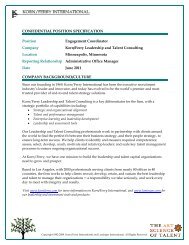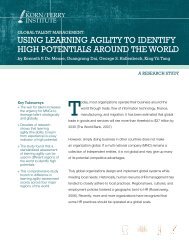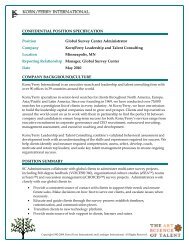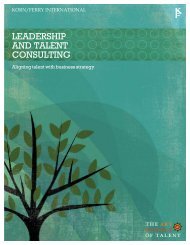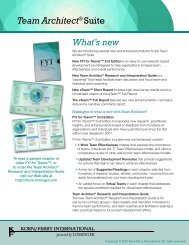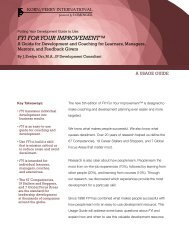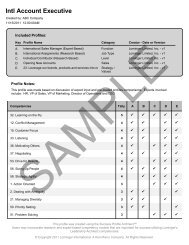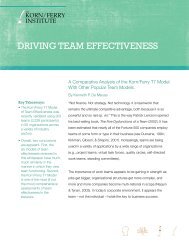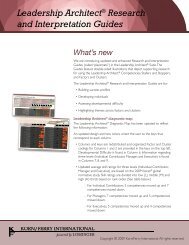understanding and applying tools to identiFy and ... - Lominger
understanding and applying tools to identiFy and ... - Lominger
understanding and applying tools to identiFy and ... - Lominger
You also want an ePaper? Increase the reach of your titles
YUMPU automatically turns print PDFs into web optimized ePapers that Google loves.
Learning from Experience – An Alternate Means ofAssessing Learning AgilityIn addition <strong>to</strong> Choices Architect ® , the Learning from Experience (LFE)Interview Guide provides an alternate means for assessing learningagility. A structured, behavior-based interview approach provides specificquestions for assessing each of the four fac<strong>to</strong>rs of learning agility.LFE has an added advantage in that it can be applied <strong>to</strong> externalselection. Choices Architect ® requires raters <strong>to</strong> be well-acquainted withthe person being rated in order <strong>to</strong> yield valid results. LFE, on the otherh<strong>and</strong>, can be applied successfully when the person being interviewed isnot familiar or well-known.LFE is an excellent complement <strong>to</strong> the results from a Choices Architect ®survey as it provides both validation <strong>and</strong> a deeper insight in<strong>to</strong> thespecific ways an individual applies <strong>and</strong> leverages his or her learningagility. This lends value in both succession planning <strong>and</strong> developmentapplications.Developing Learning AgilityIdentifying learning agility is just the start. Potential is not static in nature.A high potential <strong>to</strong>day is not necessarily a high potential <strong>to</strong>morrow.Without new challenges <strong>and</strong> experiences <strong>to</strong> inform learning <strong>and</strong> newopportunities <strong>to</strong> apply those lessons learned, learning agility can growstale. Also, even individuals who are high in learning agility may havelower scores in several dimensions. Therefore, continuing <strong>to</strong> nurture <strong>and</strong>reinforce learning agility is a high priority.Two specific resources are available <strong>to</strong> support <strong>and</strong> enhance effortsat developing learning agility: High Learning Agility Profiles <strong>and</strong> FYI forLearning Agility.10High Learning Agility Profiles – Highlights Seven DistinctTypes of Learning AgilityLearning agility is a complex set of characteristics. Therefore, it is notsurprising that learning agile people, while sharing some common traits,also tend <strong>to</strong> differ in terms of their specific learning agility strengths<strong>and</strong> weaknesses. Recent research has revealed that there are sevendistinct types of high learning agile people that are frequently observed.Underst<strong>and</strong>ing an individual’s particular learning agility profile hasimplications for determining how <strong>to</strong> best deploy <strong>and</strong> develop thatperson’s talents.



